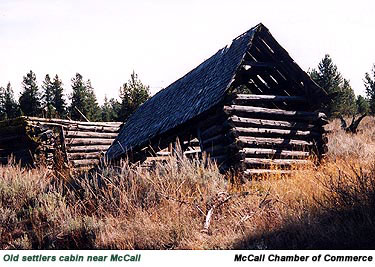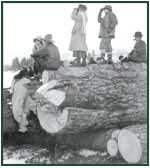Native Americans were discovered to be the first in the West Central Idaho region about 6000 to 8000 years ago. Archaeologists have found evidence of stone tools and campsites. The wandering tribes usually stayed during the warmer seasons, and migrated to the lower elevations during winter.
The first known activity in the area was fur trapping. Between 1824 and 1832 the Fur Trade was booming. The American Fur Trading Company and Britain's Hudson Bay Company had groups trapping along the Snake River and its tributaries including the Payette and Weiser Rivers. The most famous of these trappers was Jedediah Smith, who was in the valley in 1927.
In 1834 the Hudson Bay Company built "Fort Boise," a trading post along the Boise River. Fort Boise was a major stop along the Oregon Trail. It was more successful as a stopping place instead of a fur trading post. A French trapper named Francois Payette managed Fort Boise for several years. Even though it was reported that he had never explored in this area, the Payette River, Payette Lakes, and Payette, Idaho were named after him. After 1844, the price of beaver pelts had fallen so low that the trappers had to leave the area.
Idaho soon became a "wilderness " again as all the trappers left, and the trading posts vanished.
The only white settlement was the Cataldo Mission in Northern Idaho. Idaho was mostly empty as all the wagon trains passed on through on the Oregon Trail.
In 1860, Idaho received its unofficial wake up call: Gold was discovered in Pierce. Literally overnight, temporary mining camps sprang up. Orofino, Elk City, and Warren had the biggest camps. The closest mining camp here in the McCall area was Lake City, which was just east of Lick Creek Road.
The first real permanent settlement in Long Valley was a freight station, set up by Packer John Welch in 1860, near present day Cascade. He was in charge of setting up a freight system that brought good from the Umatilla River in Oregon via Lewiston, to mining camps in Idaho City, north of Boise.
Then the first Homesteaders came to Long Valley in the 1880's, they found rivers filled with trout, salmon, and whitefish. The settlers salted them and put them in barrels and sold them in the Boise Valley.
The settlers also found abundant wildlife such as elk, deer, and bear which sustained them during the long winters. Carrots and Peas were the main crops that people sold down in Boise.
 In the early 1880's McCall had its first settler. Tom Devers had a cabin on the south shore of Payette Lake. He claimed squatter's rights and had several acres where Main St. is located now.
In the early 1880's McCall had its first settler. Tom Devers had a cabin on the south shore of Payette Lake. He claimed squatter's rights and had several acres where Main St. is located now.
Tom McCall and his family came to the Valley in 1889. He arrived in the winter and first thought the frozen, snow covered lake way a large meadow. He and his family fell in love with the area and eventually talked Devers into trading a team of horses to Devers in exchange for his rights for the land and cabin. Soon other settlers arrived and a post office was created with Tom McCall named as postmaster.
McCall bought a sawmill on the lake, and he and his sons used the lumber for the new homes and businesses that were popping up all over. By 1870, McCall had 2 general stores, a blacksmith shop, a butcher shop, and the McCall Hotel (where new lee Rink is being built). The Lakeview Motel stoodfor 50 years before it burned was located where the current Hotel McCall is now.
In the early days, heavy trading and bartering provided goods and services. When cash was needed for purchases, usually for supplies bought and shipped from Boise, people had to work dawn to dusk to barely earn a living. The pay was $1.00 a day for men and $.50 cents for women. The cost for some items included $2.00 for shoes, $4.00 a ton of hay, sugar was $.50, 200 pounds of onions $1.50. One dentist offered to have 2 of your teeth pulled for $1.25.
McCall was growing slowly, and was the third largest town in the valley, besides Roseberry and Crawford, which were located on the shores of the Payette River, just northwest of Lake Fork. The town of Roseberry had decreed, "Vending of intoxicating drinks and the maintenance of indecent resorts should be prohibited". Roseberry had the first bank and operated the valley telephone exchange. In 1914 the Oregon Short Line finished laying railroad tracks from Emmett to McCall. The Railroad renamed McCall to Lakeport, as the depot was set up to unload goods to be taken by wagon to the steamers operating on PayetteLake. The local townspeople finally persuaded the Railroad Company to rename it back to McCall in 1916. The McCall Depot was built where the current Toll Station Restaurant is now.
 The railroad brought prosperity to Cascade, Donnelly, Lake Fork and McCall, and had a devastating effect on the outlying towns. It forced the outlying towns to move homes and businesses closer to the Railroad. Towns like Roseberry, Spink, Elo, Center, and Alpha (the school is now the Alpha Grange Hall on Hwy 55 South of Donnelly) disappeared virtually overnight. Several just left the area entirely. An important figure in McCall's history had arrived in McCall, just before the railroad and his name was Carl Brown. He came to Idaho from New Hampshire.He remembered seeing McCall for the first time and described it as "a straggling, one-street town on a lovely lake."
The railroad brought prosperity to Cascade, Donnelly, Lake Fork and McCall, and had a devastating effect on the outlying towns. It forced the outlying towns to move homes and businesses closer to the Railroad. Towns like Roseberry, Spink, Elo, Center, and Alpha (the school is now the Alpha Grange Hall on Hwy 55 South of Donnelly) disappeared virtually overnight. Several just left the area entirely. An important figure in McCall's history had arrived in McCall, just before the railroad and his name was Carl Brown. He came to Idaho from New Hampshire.He remembered seeing McCall for the first time and described it as "a straggling, one-street town on a lovely lake."
After trying his hand at mining, he landed the mail contract for the mail route from McCall to Warren. He carried the mail on foot, by dogsled in winter, on horseback, by stagecoach, by boat when the road was impassable, and eventually by car.
Meanwhile, Theodore Hoff who had come to McCall from Minnesota bought the sawmill and a flour mill that was located beside the sawmill. He had operated the mills for several years and was just barely getting by. Hoff met with Carl and decided to form a partnership, creating the Hoff and Brown Lumber Company. Hoff ran the mill, and Brown concentrated on logging, as he was very familiar with the surrounding area from his years delivering the mail. Their first big contract was for 250,000 railroad ties.
As the mill grew and became the main employer in the area, McCall and the surrounding area became big enough and separated from Boise County. Other changes occurred: The Railroad had completed its track to McCall, the first automobile had arrived and a daily route was set up to Meadows. Hoff & Brown also donated the money to accredit the high school (which was located at the top of the hill across from the Maverik Convenience Store) to a full 4-year school.
Warren, Carl's son became famous for sled dog racing. He was featured in the Saturday Evening
Post, New York Times and the Los Angeles Times. Like his father, he had great business sense and his first "real "job was shining shoes at one of the hotels for 75 cents a shine.
In 1922, Carl was elected to the State Legislature. He never introduced any legislation, never made speeches, and served on few committees. After his term he went back to the lumbering business.
Hoff then dissolved the partnership and opened a mill in Horseshoe Bend, leaving Carl to run the mill during the Depression years. Brown Tie & Lumber struggled during these years as the orders were canceled due to tough times. The Civilian Conservation Corps came to McCall in 1932. The federal government placed orders to provide lumber to build camps. Carl helped out the camps by supplying names for foremen, food suppliers, and the best locations for the camps and roads. The main camp was where the Browns Palace Condos are now.
placed orders to provide lumber to build camps. Carl helped out the camps by supplying names for foremen, food suppliers, and the best locations for the camps and roads. The main camp was where the Browns Palace Condos are now.
In 1938, Hollywood came to McCall. Northwest Passage was filmed on Payette Lake and the surrounding area. Robert Young, Spencer Tracy, and Walter Brennan stayed in the area during filming.
The Forts were built using Brown Lumber. The current Girl Scout Camp had a "fort" and east of the Shore Lodge were stables built for the horses used in the film. About 900 people, many from the area, were paid $5. 00 a day to star as extras, or to help build sets.
In 1938, Carl Brown deeded 80 acres of land 3 miles west of McCall to the Forest Service, creating the Payette Lakes Ski Area. Now known as the Little Ski Hill, Brown donated the Lumber for the lift, lodge, and a ski jump, which was damaged in 1991 and then torn down. The Hill is still in use today to train the Mitey-Mite skiers.

Lewis & Clark Trail
Discover the legacy of The Lewis and Clark Trail which passes through north central Idaho. The story of Captains Meriwether Lewis and William Clark and the Corps of Discovery continues to fire American imaginations. Traveling nearly 8,000 miles in 28 months, the Lewis and Clark Expedition crossed the territory of the newly acquired but uncharted Louisiana Purchase, and beyond to the Pacific Ocean.
They walked, rode, and paddled for a total of 2 years, 4 months and 9 days. This was one of the most remarkable and productive military expeditions and scientific explorations in American history. The magnitude of their journey is equivalent to today's exploration of space.
Click here to read more.